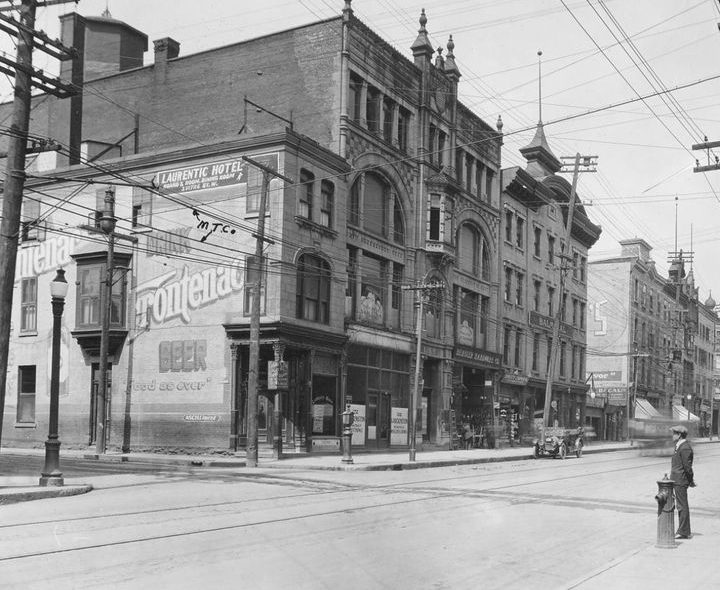Last Thursday, a fire unfortunately destroyed The Robillard, a historic 19th-century building in Montreal’s Chinatown district. As a heritage building, the Robillard certainly lived up to the designation with its historical significance: it was the birthplace of cinema in Canada.
On June 27, 1896, naval officer Louis Minier and his assistant Louis Pupier organized Canada’s first public screening using a new device called the cinematograph. Developed by French filmmakers Auguste and Louis Lumière, the invention could project movies as well as record them — in direct competition with Thomas Edison’s Vitascope projector.
Six months prior, the Lumières had revealed their world-changing motion picture technology for the first time to the public and charged for admission. Among several other films, Sortie de l’usine Lumière de Lyon (Workers leaving the Lumière Factory) was screened in Paris on Dec. 28, 1895, at the Grand Café on the Boulevard des Capucines. Soon the Lumières licenced their creation to entrepreneurs around the world, including Minier and Pupier. In fact, the Montreal screening was not only the first screening in Canada, but the first in North America — the Lumière cinematograph made its American debut at Keith’s Union Square Theater in New York, just two days after Montreal.
At that time, Robillard was used as a variety and vaudeville theatre — the idea of a movie theatre did not yet exist, of course — but Minier and Pupier’s demonstration proved to be so successful that the theatre was booked for a two-month run of the cinematograph before the duo toured the new technology around Quebec.
While that historic day in June in Montreal is now proven to be the first movie screening in North America, for many years Canadian film historians reported erroneously that cinema first came to this country by Canadian entrepreneurs Andrew and George Holland, who had licensed Edison’s Vitascope for a public demonstration in Ottawa. That much-discussed screening took place in the nation capital’s West End Park on July 21, 1896. A magician provided a 30-minute pre-show before the event, in which the Holland brothers screened Edison films like The Kiss. The historic event was recreated in the summer of 2014 by community organizers.
It was only in the 1980s that French-Canadian scholars Andre Gaudreault and Germain Lacasse disabused the notion that Ottawa’s screening preceded Montreal’s. Their research revealed the discrepancies in reports from English and French media sources about Canada’s first film screening. Since Minier and Pupier had publicized the event in French (their English was supposedly not very good), the Robillard screening was never mentioned in English-language publications in Montreal at the time.
Nonetheless, French-Canadian journalists were quite taken with the Lumières’ novel moving-picture technology. Here’s one enthusiastic report fromLa Presse:
“We were shown, as in some strange phantasmagoria, scenes from different places in France. First there was the arrival of a train at the Lyon-Perrache station … you could clearly see each individual. Is [sic] was most lifelike: you really were at the station. The train left and everything disappeared … And the sea? We saw it, not immobile, but rolling its waves. Is [sic] was most striking. ‘How refreshing!’ cried a jocular fellow.”
Anglophone film historians researching the time and place of Canada’s first film screening had entirely missed the Montreal screening by examining solely English sources. “The discrepancies in the reporting of this event are a good example of what more and more historians have come to acknowledge: history is also — is mostly — a discourse, sometimes biased, made to serve interests and ideas,” wrote Gaudreault and Lacasse in “The Introduction of the Lumière Cinematograph in Canada,” an account of their research in the Canadian Journal of Film Studies.
The article also questions the idea of “firsts” in history, as the Lumière cinematograph and Edison’s Vitascope were two of several similar inventions displayed at the time to project moving pictures. For example, the Eidoloscope — a motion-picture projector created by Eugene Augustin Lauste, Woodville Latham and his two sons — screened publicly in the spring of the same year that the Lumière brothers’ and Edison’s technologies were taking off. Yet it’s rarely discussed when we talk about the “birth of cinema.”
Over a century later, the memory of the now-destroyed Robillard Building should serve as a reminder that history isn’t always as neatly squared away as textbooks might want us to believe — and that in the realm of Canadian cinema, Quebec has always been ahead of the curve.

